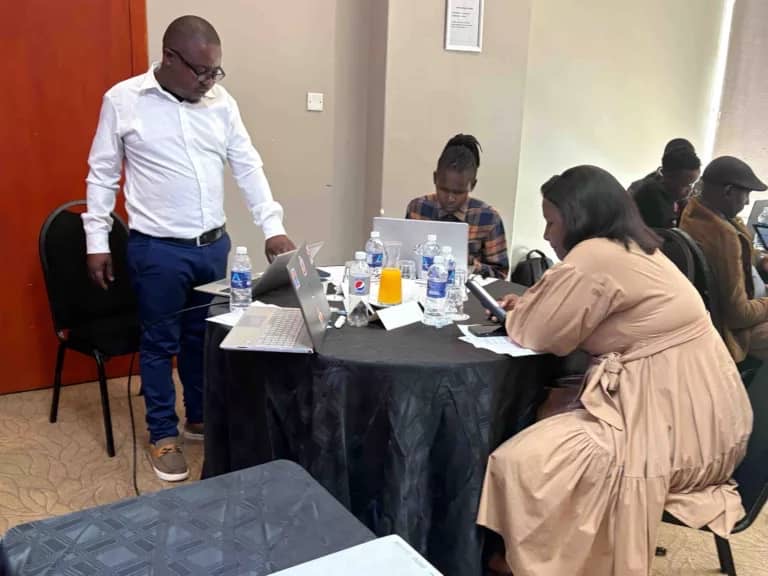By Edward Makuzva
The Zimbabwe Civil Society Organizations Scaling Up Nutrition Alliance (ZCSOSUNA), with financial and technical support from UNICEF in collaboration with key government ministries and departments, conducted a training workshop aimed at capacitating journalists with skills to move beyond statistics and embrace data-driven storytelling.
The media training workshop was held this Tuesday in the capital, with a focus on enhancing the capacity of media practitioners to use data-driven storytelling as a powerful tool for uncovering meaningful insights into the country’s food and nutrition landscape.
By strengthening the media’s ability to report accurately, compellingly, and responsibly on food and nutrition-related issues, ZCSOSUNA aims to catalyze a shift in national consciousness—where informed storytelling inspires action, transforms public attitudes, and ultimately contributes to the broader goal of ending all forms of malnutrition in Zimbabwe.
Speaking to the media during the training, ZCSOSUNA Coordinator, Kudakwashe Zombe, reaveled that the civil society network aims to raise public awareness and engage citizens on nutrition-related issues.
“Through the media training, we aim to empower citizens with knowledge about their right to nutrition, which is enshrined in the Constitution of Zimbabwe. Specifically, Section 77 of the Constitution clearly states that every person has the right to safe, clean, and potable water and sufficient food.
“This right is not just aspirational—it is a legal and constitutional guarantee. By equipping journalists and media practitioners with the tools and information to report effectively on nutrition issues, we hope to amplify public awareness and foster greater accountability.
“The media plays a critical role in educating communities, influencing public discourse, and holding both policymakers and service providers to account. When citizens are aware of their constitutional rights—such as the right to adequate food—they are better positioned to demand action from their leaders and contribute meaningfully to national dialogue on food security and public health”, Zombe explained.
Moreover, this training serves as a platform to bridge the gap between communities, experts, and government structures, ensuring that nutrition is not sidelined but recognized as a fundamental human right.
Zimbabwe’s stunting rate currently stands at approximately 24%. Based on the World Health Organization’s classification, this places the country in the high category. To move into the medium category, the stunting rate must be reduced to below 20%.
Michael Gwarisa, the Editor of Health Times, emphasized the crucial role of collaboration between stakeholders and journalists in addressing food and nutrition challenges in marginalized communities.
He urged development partners, government agencies, and civil society organizations to actively engage with media professionals to ensure that the voices and experiences of people in marginalized areas such as Binga are not overlooked.
Gwarisa highlighted that journalists can serve as vital conduits for relaying the realities on the ground, bringing visibility to communities often excluded from national conversations.
” By supporting journalists to access and report from these remote areas, stakeholders can help promote inclusive and evidence-based interventions aimed at improving food and nutrition security.
“If we are truly committed to leaving no one and no place behind, then we must invest in obtaining accurate, first-hand accounts from the most affected populations.”
Speaking at the occasion, Daily News Features Editor Beaven Dhliwayo noted that journalists should emphasize the need to look beyond statistics, highlighting the human impact of malnutrition.
“We have seen the numbers, but we need to understand the stories behind them,” he said.
“As the media, we have a crucial role to play in raising awareness about the risks associated with malnutrition and the importance of funding for nutrition programs”, Dhliwayo added.
Dhliwayo highlighted that by writing informative articles, the media can shape public opinion and prompt government action. “Our goal is to influence policy and ensure that those affected by malnutrition receive the support they need,” he added.
Through responsible reporting, the media can help bring about positive change and improve the lives of those impacted.
Dhliwayo, added that the significance of solution journalism, an approach that not only sheds light on societal problems but also offers practical solutions.
” By adopting this methodology, journalists can play a pivotal role in driving meaningful change. Rather than merely reporting on issues, solution journalism empowers media professionals to explore effective responses, fostering a more constructive and impactful narrative.
” This approach can be particularly valuable in addressing complex challenges like malnutrition, where highlighting successful interventions can inspire action and inform policy decisions. By focusing on solutions, journalists can contribute to a more hopeful and solution-focused public discourse”, he said.

